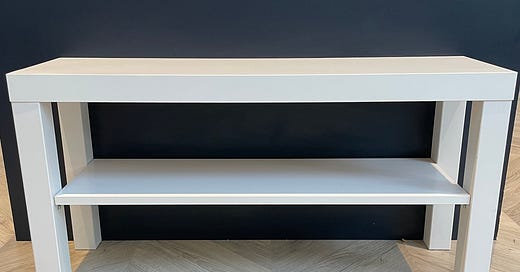Setting Up a Play Space for Babies & Preschoolers
... or how to home educate with younger kids around
The vast majority of the home education questions I get asked, are how to navigate home educating multiple ages. Or, more specifically, how to cater for babies and preschoolers.
Now, I personally don’t refer to myself as home educating my younger kids. If I wasn’t home educating their older siblings, they’d simply be at home with me playing, so that’s the basis on which I set-up an area for them in the house. I have, however, made changes this year to make their space more intentional, so the the younger children have their own “work” whilst I concentrate on their older siblings.
A little background for context. For over a decade I have been a passionate follower of Maria Montessori’s work and her education ethos. Even before I was a home educator, I followed her ideas for the toys (work) I would present to my younger children. I have used a toy rotation concept for about the same length of time. You don’t need to know anything about Maria Montessori’s work or even use a toy rotation scheme in order to follow along with my posts. However, the way I set up the children’s shelves, as well as the toys and activities I choose, are inspired by Montessori.
I don’t intend to talk in detail about Montessori’s work on this Substack. I am by no means an expert, however, if you are interested, there are many other excellent blogs and books detailing her work.
This year I have decided to trial using a theme per week for the baby (1) and preschooler (3) to drive the activities and books I display on their shelf. You do not need to have a theme for children’s play, in fact, for many years I was very anti-themed toy shelves as I felt it potentially restricted their creativity. I am a very ardent believer in play-based learning, for all ages, but more specifically, I do not seek to engage myself in my children’s play.
There are no set maths or language activities on these shelves. The aim of my setups for my younger children isn’t to teach them to read and write, but to begin to expose them to numbers and letters in line with their play.
So, why the change? A lot of our home education is topic-based learning. The children’s history, geography, science, art, music and language based learning is all woven together with a theme. This theme can sometimes last a week, a month, a term or all year. Given that this learning was themed, I felt it might work for the younger children.
Now, in my experience, younger kids (0-6 years) don’t have the same drive to really delve in to a theme as their older siblings, therefore, I decided to change the theme weekly. I will be posting these weekly themes separately, including the toys, books and activities I used. If you are interested in these posts, they form part of my paid subscription.
Whilst you don’t need anything in order to setup a play space for your younger children, I have always chosen to have a low shelf available to them. That way, their toys have a designated place in the house and they’re easily accessible. The shelf I use is actually a TV shelf from Ikea (linked here). It’s cheap, sturdy & the ideal height.
I don’t have the inclination to source a selection of brand new, matching baskets in various sizes. I source mine from charity shops, selecting the ones that are flattish with an edge that will prevent any items falling off. I have also used cardboard lids from shoe boxes or boardgames, as those are often fairly robust. Whatever you decide to use, keeping each toy on the shelf in its own basket will keep the space looking clean and inviting for play. Encourage your child to return items to the basket after play and the basket back to the shelf. I do this by modelling the clean up alongside them.
One final tip when displaying items on the shelf: make sure the item is “undone”, for example, puzzles should be stored ready to go, not finished. Items to post into a box (for example) should be displayed next to the box. Leave a book open on an interesting page. The aim is to encourage a child to engage with the shelf, not to look at a selection of finished items.
I hope this post has inspired you to start a baby/preschool set-up of your own. If space allows, pick a location for their toys that means they are included in the rest of the family space, not hidden away in a bedroom.
If you are interested in how these spaces can be used for each topic, check out my weekly baby/preschool posts.




